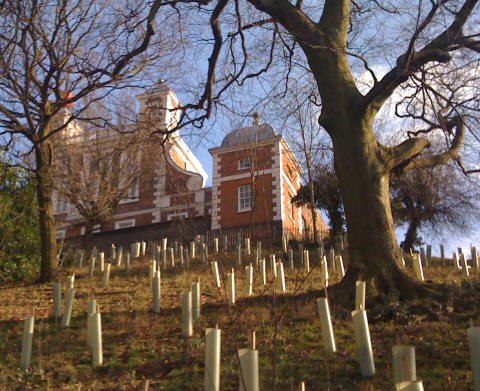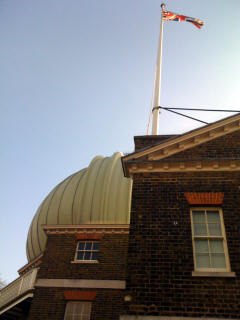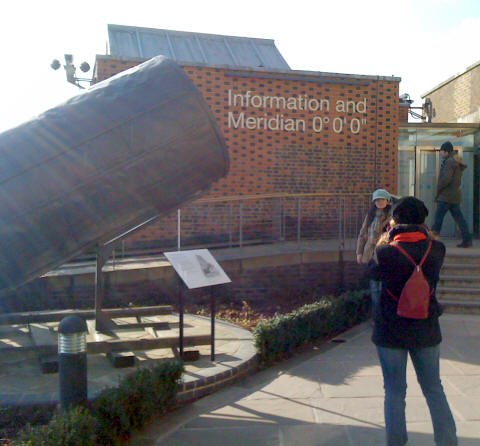伦敦皇家天文台的格林威治子午线

Table of contents
格林威治子午线将东西分开,就像赤道将南北分开一样。 它是一条从北极到南极的虚线,经过英国、法国、西班牙、阿尔及利亚、马里、布基纳法索、多哥、加纳和南极洲。
格林威治子午线,即经度0°,穿过历史悠久的艾里转环望远镜,该望远镜位于伦敦东南部的格林威治皇家天文台。 这条线穿过院子里的地板。 人们从世界各地涌来,分别站在东半球和西半球!这是一条线,所有其他经度线都是从这条线开始的。测量。

格林威治皇家天文台
在17世纪之前,各国选择自己的位置来测量世界上从东到西的距离。 这包括加那利岛的埃尔埃罗和圣保罗大教堂等地点!然而,国际旅行和贸易的增加使得在17世纪有必要走向坐标的统一。
众所周知,经度可以用地球表面两点的当地时间之差来计算。 因此,尽管水手们可以通过研究太阳来测量他们所在地的当地时间,但他们也需要知道另一地点的参考点的当地时间来计算他们的经度。 确定另一地点的时间才是关键。问题。
1675年,在改革时期,国王查理二世在伦敦东南部皇家拥有的格林威治公园建立了格林威治天文台,以改善海军航行并利用天文学建立经度测量。 同年3月,天文学家约翰-弗兰斯蒂德被国王任命为他的第一位 "皇家天文学家",负责该天文台的工作。
这些被称为 "月球距离法 "的计算结果后来在《航海年鉴》中发表,并被水手们用来确定格林威治时间,这反过来又使他们能够计算出自己目前的经度。
斯基利海军的灾难促使人们在追求测量经度方面采取进一步的行动。 这场可怕的灾难发生在1707年10月22日的斯基利群岛附近,由于无法准确计算船只的位置,导致1400多名英国水手死亡。
1714年,议会召集了一个被称为经度委员会的专家小组,并为任何能够找到海上测量经度的解决方案的人提供了一个难以想象的2万英镑的奖金(以今天的货币计算约为200万英镑)。
See_also: 英国女王伊丽莎白二世的钻石庆典然而,直到1773年,委员会才将该奖项授予来自约克郡的细木工和钟表匠约翰-哈里森,以表彰他的机械计时器--航海天文钟,该计时器在19世纪的水手中超过了月球法,受到欢迎。
 主子午线
主子午线
与经度的测量有内在联系的是时间的测量。 格林威治标准时间(GMT)建立于1884年,当时在国际子午线会议上,决定将本初子午线放在英国的格林威治。
直到19世纪末,还没有国家或国际的时间测量准则。 这意味着一天的开始和结束以及一小时的长度因城镇和国家而异。 19世纪中后期工业时代的到来,带来了铁路和国际通讯的增加,意味着国际时间标准是需要的。
1884年10月,应美国第21任总统切斯特-阿瑟的邀请,在华盛顿特区举行了一次国际子午线会议,以建立一条经度为0°0′0 "的本初子午线,通过它来测量每个地点的东或西距离,划分东西两半球。
See_also: 约克的罗马皇帝共有25个国家参加了会议,并以22票对1票(圣多明各反对,法国和巴西弃权),选择格林威治为世界主子午线。 选择格林威治有两个重要原因:
- 继前一年10月在罗马举行的国际大地测量协会会议之后,美国(尤其是北美铁路)已经开始使用格林尼治标准时间(GMT)来建立自己的时区系统。
- 1884年,世界上72%的贸易都依赖于使用宣称格林威治为本初子午线的海图的船只,因此人们认为,选择格林威治而不是巴黎和加的斯等竞争对手,总体上会给人们带来更多的不便。
 虽然格林威治被正式选为本初子午线,从天文台子午线大楼中的 "过境圈 "望远镜的位置开始测量--该大楼是由第七任皇家天文学家乔治-比德尔-艾里爵士于1850年建造的--但全球的实施并非一蹴而就。
虽然格林威治被正式选为本初子午线,从天文台子午线大楼中的 "过境圈 "望远镜的位置开始测量--该大楼是由第七任皇家天文学家乔治-比德尔-艾里爵士于1850年建造的--但全球的实施并非一蹴而就。
在会议上做出的决定实际上只是建议,各国政府有责任按照他们认为合适的方式实施任何改变。 对天文日进行普遍改变的困难也阻碍了进展,尽管日本从1886年起采用了格林尼治标准时间,但其他国家却迟迟没有效仿。
二十世纪初,又是技术和悲剧促使人们采取了进一步的行动。 无线电报的引入提供了向全球广播时间信号的机会,但这意味着必须引入全球统一性。 通过在埃菲尔铁塔上安装无线发射器,他们确立了自己在这项新技术上的领先地位、法国不得不屈从,从1911年3月11日开始使用格林尼治时间作为其民用时间,尽管它仍然选择不实施格林尼治子午线。
直到1912年4月15日,泰坦尼克号撞上了冰山,1,517人丧生,使用不同子午线点的混乱现象才最具有破坏性地显现出来。 在对这场灾难的调查中,人们发现,法国的拉图恩号给泰坦尼克号的一封电报指出了附近的冰原和冰山的位置,使用的时间是同一天。虽然这种混淆并不是灾难的总体原因,但它无疑提供了思考的素材。
第二年,葡萄牙人采用了格林威治子午线,1914年1月1日,法国人终于开始在所有航海文件上使用该子午线,这意味着所有欧洲航海国家第一次使用共同的子午线。

博物馆 s
到达这里

